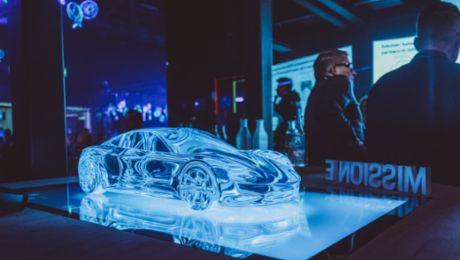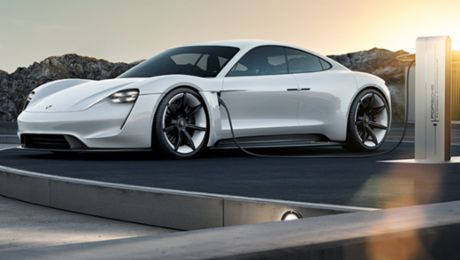Mr Michael, why is Porsche forging its own path in terms of charging technology?
Fast loading is a great match for our intelligent performance strategy. We’ve closely examined what customers really expect from e-mobility, and what they actually want. There are two key challenges in this respect: the power and performance of e-vehicles and, following on from this, the infrastructure. Customers have two main concerns in this regard, namely inadequate ranges and long charging times.
These are the concerns which a competitor hopes to address with its “superchargers”.
Yes. But we intend to revolutionise charging times by doubling the capacity of the high-voltage system from 400 V to 800 V. In a nutshell – a range of 400 km in less than 20 minutes. Without exception, all our current competitors are advertising charging durations which are twice as long.
The IT industry has coined the term “killer app” to refer to a leap forward of this kind which is a huge hit with customers.
I’m not going to argue with you there. But the Porsche approach involves more than simply being fast. Our goal is not just fast charging, but also extremely convenient charging.
What does that mean?
Most drivers charge their e-vehicles at home. And so we’re offering intelligent wall boxes. We call them intelligent because you can use an app with a timer to select charging times when power is cheap. You can also heat or cool the passenger compartment of your vehicle as appropriate for the weather before setting off.
Presumably the aim is still for Porsche e-vehicles to achieve outstanding speeds?
Of course. We’ll also be able to tailor charging output to customer needs. For example, 3.6 kW for a plug-in hybrid or 7.2 kW for drivers who want to go faster in their Porsche vehicle. For purely electric vehicles, the customer can choose between 11 kW and 22 kW.
Some energy suppliers are already quaking in their boots at the thought of “dentist streets”.
What on earth are they?
Residential areas which are home to particularly high numbers of owners of powerful e-vehicles. If they all decide to charge their SUVs at the same time using high-kW outlets, the lights might go out throughout the entire district.
We’re well aware of this challenge, and of course we’re talking to the energy suppliers. One e-vehicle can quickly double the power consumed by a household. We are therefore offering an integrated energy management system which regulates the power supply during the charging process on an as-needed basis.
What other plans do you have?
We view the entire charging infrastructure – including the charging stations – as a single unit. For example, our turbo-charger has built-in storage which can be used to charge three all-electric vehicles, one after another, without connecting to the grid. It can even be topped up using solar energy. This is extremely important in countries where the supply of power via the grid is not as seamless as it is in Germany, and variability is commonplace.
That sounds like a challenge.
Challenges are what push us to our very best. We gave a great deal of thought to how we could meet the specific expectations of Porsche customers. And that was exactly where we started – with something no one has done before.
An 800 V electrical system?
Exactly. Because that allows us to achieve something our customers particularly value in a Porsche vehicle – an optimised power-to-weight ratio, even when charging.
What does that mean?
Physicists use the equation P = U x I, or in other words power equals voltage times current. So if you want more power, you have to change one of these two variables. Up until now, all the automotive manufacturers have done that by increasing the current. But this means that the cables have to get thicker, which in turn means a huge increase in weight, and the limits of the system are quickly reached. To circumvent this problem, we’re increasing the voltage in our charging system.
Isn’t it a problem if only Porsche is offering an 800 V vehicle?
No. We’re proud of the fact that the global standard has been adjusted to 1000 V.
Is there not a risk that we’ll end up with a mishmash of different standards?
There’s no chance of that happening, because the plugs are all the same.
What is your opinion of inductive charging?
There are still many technical challenges that need to be addressed in this area. We’re delighted that all the brands within the Volkswagen Group are working together to find a uniform solution. This will go a long way towards setting a benchmark. Initially at any rate, inductive charging will only be an option for at-home charging. That is, however, where 80 percent of all charging takes place.
High-performance e-vehicles have a 48 V electrical system – which concrete benefits does this provide for the vehicle?
This is often a source of confusion in public debates on the matter. Ultimately, the electrical consumers determine which electrical system is most useful. For example, 1.5 V is best for the microcontrollers in the car. The classic 12 V architecture is extremely robust. But if you want to operate high-performance assistance or chassis systems at lightning speed and in real time, such as the roll stabiliser, you need a 48 V electrical system. It can also be used for redundant systems in addition to a 12 V electrical system in order to achieve automated driving.
The ranges of 500 km or more which are so sought after by customers require more powerful batteries. Is Porsche is working together with external partners in this area?
Yes, it’s important to us to have a say in all the key properties of the batteries, because the cells in our high-performance sports cars must do more than those in standard cars. The current state of battery cell development means that compromises still have to be made. That’s why a particularly well-balanced overall system is a great boon for us. All the auxiliary units, for example the cooling system, must also be precisely tuned to ensure that our vehicles can deliver top performance over long periods. That’s why we’re building direct contacts with the relevant battery cell manufacturers.
Like LG or Panasonic?
Exactly. Their past history makes them battery experts, in particular when it comes to smartphones and their requirements. The requirements which must be met by vehicle batteries – in terms of performance, safety and durability – are however a great deal more challenging. And a well-manufactured cell does not necessarily result in a high-performance battery. We need to work together with the manufacturers of all the various components. And we must not forget the auxiliary units which need to be adapted to meet the specific requirements of an electric vehicle. Last but not least, it’s also important for us to bring our influence to bear on the work carried out by all-in-one system suppliers. This is because the batteries have a major influence on driving dynamics, for example. Off-the-shelf procurement is simply not an option for Porsche.
It sounds like the development work carried out by Porsche in relation to electric motors will not differ significantly from that carried out for traditional combustion engines.
That’s true. We want to be involved in the development of all the relevant characteristics. The only thing that differs from the development of a combustion engine is that we are developing the combustion process itself. We’re imposing our own requirements at the level of cellular chemistry.
Are there likely to be any technological revolutions in terms of significantly increased battery power in the foreseeable future?
Our Mission E vehicle already demonstrates quite a high level of development. We also anticipate that the efficiency of traditional lithium-ion batteries will improve by up to 5 percent per year in the foreseeable future. In the long term, these foreseeable improvements alone will result in hugely increased power.
What is your take on the liquid-free batteries which have generated quite a lot of excitement?
You mean solid-state electrolyte batteries. We don’t expect to see models which are suitable for use in cars before 2025. We’ve already made a great deal of progress in this area with our partner Quantumscape. The use of lithium-air technology is also a very exciting prospect.
How long will this take?
Realistically speaking, we’re unlikely to see this technology in series-production vehicles before 2030.
Given the lengthy development cycles in the industry, that hardly sounds like science fiction. It’s harder to believe that fully autonomous driving will become reality in the near future.
Make no mistake. Porsche does not regard Level 5 automation – driving without a steering wheel, brake and accelerator pedal – as a priority, but we we’ve already made some huge leaps forward in the field of automated driving: congestion assistants, manoeuvring guidance systems... these are already par for the course. Digital networking and the “Car for Life” concept mean that it may also be possible to ensure that a customer’s vehicle is fit for the future without the customer needing to visit a Porsche branch.
How might this be achieved?
We already use over-the-air technologies to keep infotainment systems up-to-date...
…like when my smartphone updates itself overnight?
Yes. The same thing will start happening in many other areas.
Such as the chassis, engine performance or safety features?
A great deal is feasible. Some services will be mandatory updates of existing functions. Drivers will be able to select others individually as and when they need them, and maybe even temporarily. Increased engine power or a new aquaplaning warning service are just two examples.
Could this aquaplaning service also warn the car behind me?
Absolutely, using swarm intelligence. But there are also lots of electronic services which simply make life easier for drivers behind the wheel.
Can you give any examples?
Why shouldn’t it be possible for delivery companies to deliver packages to my luggage compartment via remote opening enabled through an app? Why shouldn’t my vehicle direct me to a vacant parking space, and reserve it and pay for the parking ticket at the same time? Many little conveniences of this kind are conceivable for vehicle owners.
Using apps in the car display?
Exactly. We’ve expanded our expertise enormously in this area.
Couldn’t you have left this job to independent app developers?
We want to be sure that the apps are up to Porsche standards in terms of design and ease of use – which is just what Porsche customers expect. This is a part of our brand equity, which is becoming ever more important.
Like when Porsche first installed touchscreens in its vehicles?
We were the first in Germany. Because we listened to our customers, and heard what they were saying about how they wanted to operate their vehicles. Today our touchscreens respond to as many gestures as an iPhone.
So, following in Apple’s footsteps is the route to success?
At the 24 hours race of Le Mans we managed quite well without Apple in our 919 Hybrid… but you’re quite right – as far as digital services and hardware or software are concerned, we have a lot to learn by working in partnership with IT companies. Yet all of our original electronics are always focused on bringing that special Porsche feeling into the driver’s life.
Can you provide us with a specific example?
It goes without saying that assistance systems are a priority for us. Because our customers prefer a sporty driving style even at night, we need particularly intelligent lighting systems which can look further ahead than any human. This requires not only the right technology, but also networking and digital services. Or take the Turbo Charging Planner for our battery electric powertrains as another example; quick-charge options are optimally matched to your route planning and charging pedestals are pre-reserved, meaning that you can gain that all-important advantage and lose as little time as possible. Added value of this kind helps to determine the essence of the brand.
The digital networked world is currently undergoing yet another revolution – powered by artificial intelligence. Will this also alter our driving experience in a Porsche?
Driving a Porsche is always a supremely enjoyable experience. Artificial intelligence will enrich this experience yet further. Self-learning systems are the natural outcome of modern-day semi-conductors which have the capacity to process and network huge amounts of data either in back-end systems or locally in the vehicle itself.
And what is the advantage of these systems?
Artificial intelligence means that these systems will get better and better at understanding drivers’ natural speech, even if they’re speaking Urdu or Azeri. Highly automated driving in a complex environment will become feasible only when we have systems that continuously get smarter on their own.
Are you not afraid that artificial intelligence might also replace you and your colleagues in future?
There’s no reason whatsoever to worry about that happening. On the contrary, I hope that artificial intelligence will help me to work a lot smarter. The systems for reproductive learning already perform extraordinarily well, and help me to find the information I need. Even in the future, though, engineers will have the upper hand in terms of creative thinking.
Info
Uwe Michael (58) studied electrical engineering, specialising in solid-state electronics, at the Technical University of Darmstadt. After graduating as an engineer, he spent 15 years working for the automotive supplier VDO Automotive AG in a variety of roles. After that, he was responsible for several locations in Germany and abroad as head of department at Mannesmann AG. In 2001, Uwe Michael joined Porsche and has headed up a department within the Electrics/Electronics (EE) Development Division ever since.





